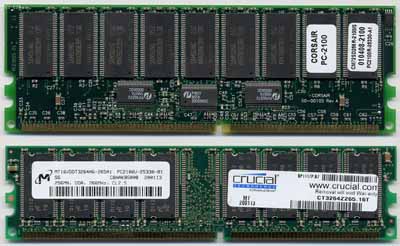Tyan's Tiger MP: Affordable Multiprocessing
by Anand Lal Shimpi on September 26, 2001 4:36 AM EST- Posted in
- Motherboards
Memory Support: The good and the bad
Very few people realize how difficult it is to implement 4 DIMM slots connected to a 64-bit DDR266 memory bus while maintaining stability. It's not a surprise that only a handful of motherboard manufacturers have been able to accomplish such a feat. Iwill is one of them, and of course, Tyan is as well.
One of the requirements for the 4 DIMM slots present on the Tiger MP is that all of the modules must be registered DDR SDRAM modules. A "registered" memory module helps to reduce loading (electrical not data load) on the memory bus by buffering address lines through registers on the modules themselves. The end result is that more memory slots are able to be used on a motherboard. This is actually a very common requirement for most server and high-end workstation motherboards that will be used in cases with a lot of memory. The Tyan Thunder K7 that powers the AnandTech Forums Database server for example has all four DIMM slots filled, each with a 512MB DDR266 module. Had larger modules been available, the board would have been filled with those instead.
The Tiger MP keeps the 4 DIMM slots of the Thunder K7 which is a good thing since efficiency in higher end applications is not only governed by CPU and platform performance, but memory size as well. This also forces it to keep the registered DDR SDRAM requirement, but only if more than two banks are populated. If you only install two modules then you should be fine with regular DDR SDRAM (provided that it has no specific compatibility issues with the Tiger MP). During our tests we ran the board with Corsair Registered DDR SDRAM modules and the same Crucial unregistered DDR SDRAM we use in all of our other tests. As long as only two slots were filled, the stability was identical and the performance was roughly the same (the unregistered modules are theoretically faster but that doesn't translate into any tangible performance gains). When more than three unregistered DIMMs were installed the system would not POST; and adding a third registered DIMM to a set of two unregistered DIMMs would not boot either.

Registered Corsair (Top), Unregistered Crucial (Bottom) - Click to Enlarge
In order to reduce the size of the motherboard Tyan has unfortunately gone back to perpendicular DIMM slots vs. the 45 degree angled slots on the Thunder K7. The benefit of the angled slots was that they'd work with registered DIMMs while in a 1U server chassis. Of course if you're not looking to rackmount the motherboard then there's no reason to even worry.










0 Comments
View All Comments